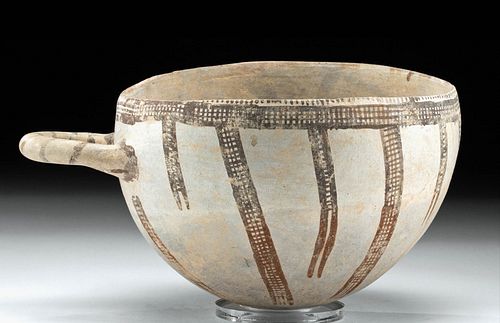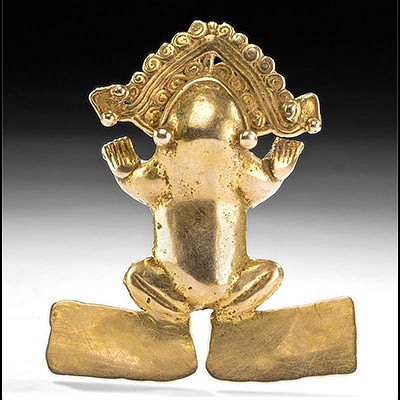Greek Cypriot Pottery Milk Bowl w/ Handle
Lot 12a
About Seller
Artemis Fine Arts
686 S Taylor Ave, Ste 106
Louisville, CO 80027
United States
Selling antiquities, ancient and ethnographic art online since 1993, Artemis Gallery specializes in Classical Antiquities (Egyptian, Greek, Roman, Near Eastern), Asian, Pre-Columbian, African / Tribal / Oceanographic art. Our extensive inventory includes pottery, stone, metal, wood, glass and textil...Read more
Categories
Estimate:
$800 - $1,200
Absentee vs Live bid
Two ways to bid:
- Leave a max absentee bid and the platform will bid on your behalf up to your maximum bid during the live auction.
- Bid live during the auction and your bids will be submitted real-time to the auctioneer.
Bid Increments
| Price | Bid Increment |
|---|---|
| $0 | $25 |
| $300 | $50 |
| $1,000 | $100 |
| $2,000 | $250 |
| $5,000 | $500 |
| $10,000 | $1,000 |
| $20,000 | $2,500 |
| $50,000 | $5,000 |
| $100,000 | $10,000 |
| $200,000 | $20,000 |
About Auction
By Artemis Fine Arts
Aug 13, 2020
Set Reminder
2020-08-13 10:00:00
2020-08-13 10:00:00
America/New_York
Bidsquare
Bidsquare : Fine Antiquities, Ethnographic & Fine Art
https://www.bidsquare.com/auctions/artemis-gallery/fine-antiquities-ethnographic-fine-art-5415
Features classical antiquities, ancient and ethnographic art from cultures encompassing the globe. Egyptian, Greek, Roman, Etruscan, Near Eastern, Asian, Pre-Columbian, Native American, African / Tribal, Oceanic, Spanish Colonial, Russian, Fine Art, so much more! Artemis Fine Arts info@artemisgallery.com
Features classical antiquities, ancient and ethnographic art from cultures encompassing the globe. Egyptian, Greek, Roman, Etruscan, Near Eastern, Asian, Pre-Columbian, Native American, African / Tribal, Oceanic, Spanish Colonial, Russian, Fine Art, so much more! Artemis Fine Arts info@artemisgallery.com
- Lot Description
Ancient Greece, Cyprus, Late Bronze Age, ca. 1550 to 1200 BCE. A beautiful pottery vessel known as a milk bowl exhibiting a cream ground color that is accentuated with several lattice-pattern columns cascading from a similarly patterned top bar. The hemispherical bowl features a rounded base with a thin rim surrounding the deep basin that is formed by molding the walls over the body of a gourd, and a parabolic handle protrudes from the backside. Additionally, a pair of black 'chains' with diamond-shaped links drape from the front of the bowl between longer columns. Lucite display stand for photography purposes only. Size: 8.375" L x 7" W x 4.625" H (21.3 cm x 17.8 cm x 11.7 cm)
The construction method of using a gourd to shape the vessel is intriguing since ancient Greek, Cypriot, and Mediterranean cultures were already accustomed to using the wheel-throwing method of making pottery. The use of a gourd suggests that, despite how the potter's wheel facilitated and expedited the creation of large volumes of pottery vessels, there was still a demand for hand-built vessels from skilled artisans. Scholars have posited that milk bowls like this were desirable because they had impermeable surfaces that made them ideal for holding hot liquids like warmed milk.
For another example of a Cypriot pottery milk bowl, please see the Yale University Art Gallery, accession number 1912.135.
Provenance: private Dere collection, East Coast, USA assembled between 1970 and 2000
All items legal to buy/sell under U.S. Statute covering cultural patrimony Code 2600, CHAPTER 14, and are guaranteed to be as described or your money back.
A Certificate of Authenticity will accompany all winning bids.
We ship worldwide and handle all shipping in-house for your convenience.
#157165Repaired from several large pieces, with resurfacing and overpainting along break lines. Abrasions and nicks to rim, body, base, and handle, with fading to original pigmentation, and light encrustations. Nice remains of original pigment on exterior of body.Condition
- Shipping Info
-
All shipping is handled in-house for your convenience. Your invoice from Artemis Gallery will include shipping calculation instructions. If in doubt, please inquire BEFORE bidding for estimated shipping costs for individual items.
-
- Buyer's Premium



 EUR
EUR CAD
CAD AUD
AUD GBP
GBP MXN
MXN HKD
HKD CNY
CNY MYR
MYR SEK
SEK SGD
SGD CHF
CHF THB
THB















